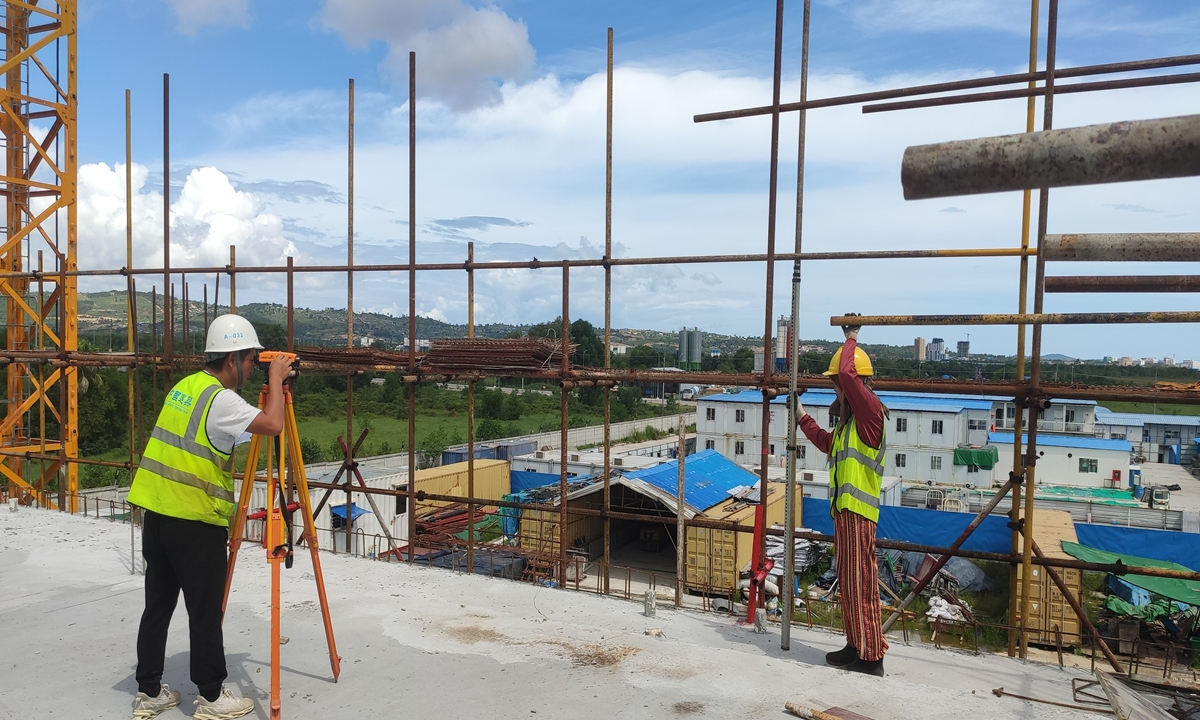
An engineer measures the height and level of a building with the help of a colleague on Monday. Photo: Courtesy of CSCEC
Inside the construction area of the Kompong Dewa Resort in Sihanoukville, Cambodia, Chinese builders from the China Eighth Engineering Bureau, a subsidiary of the state-owned construction giant CSCEC, have implemented a green construction concept to the ground.
Starting from scratch, the construction of each component of the resort village is earnestly carried out to build in a green and environmentally friendly way while conserve building materials, water, energy and land.
Each part of the project - the office building, the hotel, the parking lot - is attached with a sewage treatment plant that recycle domestic waste water for farmland irrigational use.
Wall panels of the apartment is prefabricated and enclosures are made of assembled structure blocs that can be used multiple times, replacing the traditional brick walls to reduce on-site construction waste.
Frequent rainfall in Cambodia is drained and collected to be used for washing and cleaning purposes at the construction site. Toilets used by workers are made into prefabricated mobile units, saving unnecessary construction and demolition work.
Lu Tao, project manager with Jinan, Shandong-based First Company of China Eighth Engineering Bureau, told the Global Times on Sunday that these green construction practices have saved use of construction materials by 80 percent, reducing environmental pollution and improving construction efficiency by 60 percent.
"Banking on Cambodia's 7-month-long rainy season, the rainwater harnessing system has so far saved about 1,200 cubic meters of tap water," Lu said.
Lu said the measures are devised to fit into the local condition and steps are taken in close coordination with the project owner, an Indonesian company.
Cambodia is one of the 29 countries signing on an initiative to promote green development cooperation under China-proposed Belt and Road Initiative (BRI) framework last week.
The initiative, together with another one on COVID-19 vaccine cooperation, was signed on a high-level meeting on international cooperation under the BRI in the Asia-Pacific region via a video link. Chinese State Councilor and Foreign Minister Wang Yi chaired the meeting on Wednesday.
The dense population, fragile ecosystem and existing environmental pollution challenges in many of Asian countries have made the green approach to BRI construction a necessity, Liu Ying, research fellow at the Chongyang Institute for Financial Studies at Renmin University of China in Beijing, told the Global Times on Sunday.
"Fighting the COVID-19 together is a prerequisite of local economic growth but a climate-change-oriented approach to development is a must," Liu said.
Competing B3W
The meeting was seen by some as a response to the Build Back Better World (B3W), which was proposed at the recently held G7 summit in the UK to seek an alternative to the BRI.
Chinese analysts said while the US-led B3W, scant in details, offers an outlook of how to build a better world, the BRI builders, under the principle of "consultation, contribution and shared benefits", are building a better world on the ground.
A World Bank report in 2019 highlighted the danger of infrastructure project has on natural environment, such as deforestation, soil erosion, and the destruction of habitats for wild animals.
At the construction site of the Phnom Penh-Sihanoukville Expressway (PPSHV Expressway), excessive dust made out of the process of crushing stones for building the road were sucked into a vacuum cleaner installed in a nearby sewage sedimentation tank.
China Road and Bridge Corporation (CRBC) deployed technologies to ensure eco-friendly construction of the 187-km highway. Linking the capital Phnom Penh to the largest seaport province of Preah Sihanouk, the highway will cut travel time from five hours to just two.
After completion, the $2.019-billion-project will be the first-ever expressway in Cambodia.
Environmentally-friendly technologies are applied to build a "green expressway" and some in Cambodia saw the project's role of leading the "green trend" in the infrastructure industry to protect Cambodia's environment.
As the PPSHV Expressway stretches across Cambodia's natural reserve, home to many wild animals including buffalos, the construction workers added shields along the wire mesh fence of 21 kilometers to protect the animals being hurt. Multiple special passageways for animals were also dug to ensure their free migration.
CRBC also took the initiative to protect the fragile ecosystem, tried to reduce construction work's impact on the green hills and surrounding water to avoid any land erosion.
"Our aim is to help Cambodia to enter a green future," Hu Zhaoguang, general manager of the expressway project, told the Global Times on Sunday.
The project has included building noise barriers and noise reduction forests for all the 44 noise-sensitive areas such as temples and schools.
In Dushanbe, capital of Tajikistan, another project team under the First Company of China Eighth Engineering Bureau optimized the design of the outer surface of a 113-meter-high iconic tower at the Freedom and Independence Park with lighter material, cutting emissions and transportation costs too.
"The high-standards seen in many of the BRI projects, despite being of a varying degree as determined by the local circumstances of the countries in which these projects are located, are conducive in forging the real-world standards and paradigms of BRI in the years to come," Liu said.
Not all projects implemented the green concept from the beginning and there had been twists and turns, experts noted. For instance, some Chinese contractors working in African projects once had oil seepage issues that contaminated nearby soil. Upon negotiation with the local property owners, remedy measures were taken and all the contaminated soils were replaced, as eco-friendly construction is beefed up.
On account of the urgency posed by climate change on Earth, greenness could be one of the founding principles of high-quality BRI construction, Liu said.
At last week's meeting, Chinese Foreign Minister Wang Yi pointed out that since the BRI was proposed in 2013, the initiative has made positive progress with the joint efforts of all parties, and it has become the widest and largest international cooperation platform.
Despite the impact from the COVID-19 pandemic, BRI projects continue to advance in the Asia-Pacific region.
The Laos-China Railway Co Ltd said it is sticking to its December 2 schedule to complete the construction of the China-Laos Railway, Xinhua reported on Friday, citing project manager on the ground.




